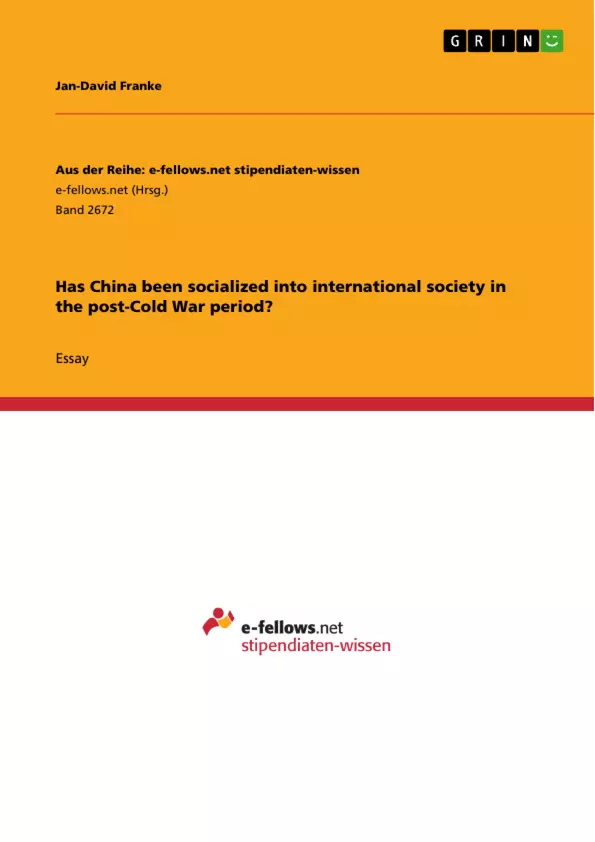With the collapse of the Soviet Union the United States benefitted from an unprecedented unipolar moment in its establishment of unilateral hegemony, be that in the form of a modern empire as Johnson (2000) and Todd (2004) argue, as an empire by invitation (Lundestad, 2003), or as liberal hegemon (Ikenberry, 2011). All of these authors feature vast disagreements regarding hierarchy and coercion in American hegemony but accept the same premise: a post-Cold War unipolar American world order. Many argue that as the unipolar moment is waning, American hegemony, and the norms, practices, and institutions of international society it has so predominantly shaped, are being challenged, however, by both the rise of other actors, first and foremost China but also a re-emerging Russia, and the endogenous deconstruction of American hegemony (see Todd’s (2004) argument on demographics and social norms and most recently the advent of power by a protectionist, isolationist nativism). In this paper I will add to that debate by evaluating the extent to which China has been socialized into international society since the end of the Cold War and, on that basis, examining what is to be expected for the future both in terms of China’s course and the implications thereof for international society. I will do so by amalgamating many different approaches and schools of thought in an attempt to be ‘paradigmatically prudent’ (cp. Monteiro & Ruby, 2009). First, I will sketch the discussion in the literature on China’s rise and contrast it by means of a syncretic framework of intentions and outcomes based on Schweller & Xiaoyu (2011) and Goh (2005). Within that framework, I present optimist and pessimist approaches derived from realism, liberal institutionalism, and constructivism and the various analytical categories they place emphasis on. I will then argue that an integration of these polarized perspectives is necessary to provide an accurate and realistic account of China’s past, present, and future role in international society that places particular importance on differentiated spheres of geopolitical influence.
Inhaltsverzeichnis (Table of Contents)
- Has China been socialized into international society in the post-Cold War period?
- China's rise and contrasting frameworks
- Optimistic and pessimistic approaches
- Integrating polarized perspectives
- The English School and spheres of influence
- Schweller & Xiaoyu and Goh: Intentions and outcomes
- Realist perspectives
- Liberal institutionalist perspectives
- Constructivist perspectives
- Realistic constructivism and differentiating levels of analysis
- China's course since the end of the Cold War: Pluralism and solidarism
- Chinese behavior and spheres of influence
- Mutual convergence: Legitimacy of international order
- Regional context: Revisionist China
Zielsetzung und Themenschwerpunkte (Objectives and Key Themes)
This paper examines the extent to which China has been socialized into international society since the end of the Cold War and analyzes the implications for both China's future course and international society. It adopts a paradigmatically prudent approach, integrating insights from realism, liberalism, and constructivism to provide a comprehensive and realistic account of China's role in international society.
- China's socialization into international society
- The implications of China's rise for international society
- The role of intentions and outcomes in shaping China's engagement
- The influence of different theoretical perspectives on understanding China's behavior
- The importance of differentiating levels of analysis by spheres of influence
Zusammenfassung der Kapitel (Chapter Summaries)
The paper begins by outlining different frameworks for understanding China's engagement with international society, contrasting optimistic and pessimistic approaches based on realism, liberalism, and constructivism. It then examines the English School's framework of three spheres of influence: the international system, international society, and world society.
The paper further explores the Realist perspective, arguing that China's rising power challenges US hegemony and the existing international order. Liberal institutionalists, on the other hand, believe that the current international order can accommodate China's rise peacefully, highlighting China's growing participation in international institutions and regimes.
The paper then examines constructivist perspectives, emphasizing the importance of interaction and identity negotiation. It critiques the limitations of both optimistic and pessimistic constructivism, proposing a "realistic constructivism" that integrates relevant perspectives from both liberalism and realism.
The paper concludes by analyzing China's behavior across different spheres of influence, arguing that China exhibits a degree of flexibility on the global stage while pursuing more revisionist policies in regional contexts.
Schlüsselwörter (Keywords)
This paper focuses on the socialization of China into international society, the rise of China as a global power, the impact of China's rise on international order, the role of institutions and norms in shaping international relations, the interplay of theoretical perspectives (realism, liberalism, constructivism), and the importance of differentiating spheres of influence (global, regional).
- Arbeit zitieren
- Jan-David Franke (Autor:in), 2016, Has China been socialized into international society in the post-Cold War period?, München, GRIN Verlag, https://www.grin.com/document/411978



